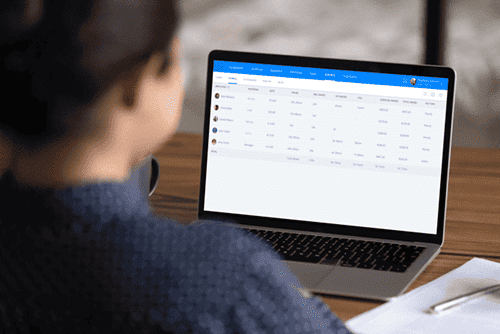How To Build An Effective Staffing Model For Your Business
Do you want to provide a structure for your business’s labor needs and get the...

If you’re looking for a new and effective way to improve how your team and your business operate, a staffing plan may be the solution.
Staffing plans can provide a framework for all of your labor needs so you can be sure your business has the right number of skilled employees to meet the demands of your market — both now and in the months and years to come.
In this article, we discuss how to develop your own staffing plan and the software that can help get you there.

A staffing plan is a collection of data points that measure and describe various aspects of the way your business operates, including foundational variables such as work activity, labor needs, and the time and money spent to get the job done.
With that information in hand, management (and your HR department, if you have one) can take steps to identify and predict:
The process of developing a staffing plan can reveal all of that — and more. But how do you go about creating such a plan?
Read on to find out.

The foundation of a good staffing plan rests on the goals and strategies you have for your business.
These milestones provide direction to your organization as a whole and give your HR department and management a baseline with which they can start formulating important questions about the business, including:
The answers to these questions — and a thorough review and evaluation of business goals — will make up the framework of your staffing plan as it starts to take shape.
Once you’ve settled on the goals you want to use moving forward, the next step in developing a staffing plan is to look for conflicts and contributions.
Take a step back from the goals themselves and try to identify things that might help your business reach those goals. At the same time, try to identify things that might hinder your business along the way.
Conflicts and contributions can exist inside and outside your organization, so don’t limit where you look.
For example, your business may be affected by:
Each of these could serve as a conflict or contribution to the way your team works and influence both the supply of talent you have available and the staffing plan you build to manage it.

Developing a staffing plan is like working backward on a road map: You put a pin in your destination and work your way backward, identifying places where you might slow down or speed up along your route until you reach your starting point.
In this case, your destination is achieving the various goals you’ve set. The slowdowns and speed-ups along your route are the conflicts and contributions you identified in step two. That leaves one variable undefined: your starting point.
After establishing where you want to go and the factors that affect your progress, it’s time to define where your business is now.
As you look at the current state of your workforce, make note of details like:
The data you gather in this step can help your business get a clear picture of where the operation is at right now and help you define the starting point of the staffing plan moving forward.
So, at this point, you’ve got a destination (the goals you want to achieve), an origin (the current state of your business), and the potential conflicts and contributions that could pop up along the way.
Now, it’s time to start planning how your business is going to move from start to finish.
At this point in the process, it’s time to decide what you need to accomplish your goals.
Think of it like preparing for a road trip. You’ll need to choose a route, decide which vehicle you want to take, and finally, throw in some clothes, a bag or suitcase to put them in, and maybe some snacks and drinks to keep you fueled during the journey.
You can use the same idea to figure out what your business needs on the road to achieving the goals you set in step one.
Make a list of everything your business might need for the “trip” — whether it’s available to you at the moment or not.
Include things like:
Once you have a list of the things you need, it’s time to separate that list into what you have and what you don’t have.
Next, go through everything on your “needs” list and determine what’s missing.
For example, you may have decided you’ll need a team of 10 to accomplish your goals. But maybe your business only has eight employees right now. Obviously, you know you’re going to need to hire two more employees before you start out.
Now that you have information for all of the variables — goals, conflicts and contributions, starting point, needs, and shortfalls — it’s time to build a staffing plan to fill in the gaps.
At this point, you’ve done most of the work already. You just need to map out how your business is going to make sure it has the resources necessary to make the journey as successful as possible.
Then, all that’s left is to start the engine and put your staffing plan into action.

The restaurant industry is notorious for its employee turnover, but that’s just the nature of running a busy food-service establishment.
You can help cut down on turnover chaos by building a staffing plan for your business. This plan may be able to help you focus on hiring for skill, fit, and longevity instead of just finding someone who can do the job today and be gone tomorrow.
In fact, hiring the right person based on your labor needs and your staffing plan can help your restaurant develop a reputation for quality service.
And that doesn’t just come from your servers. Everyone from the head chef to the dishwashers and food runners can help your restaurant stand out from the crowd.
But it all starts with developing a staffing plan that can help you find exactly what your food-service business needs to get ahead.

Once you’ve built a staffing plan that’s right for your business, it’s time to put it into action. That involves managing everything from the hiring and firing process to the way you organize and optimize your team.
The Sling suite of tools can help you simplify and streamline all of that and give your business unprecedented control over the finer and more difficult points of workforce management, including:

Try Sling for free today to see how it can help you take your staffing plan off the paper and make it into a reality.
And, for even more free resources to help you manage your business better, organize and schedule your team, and track and calculate labor costs, visit GetSling.com today.
See Here For Last Updated Dates: Link
This content is for informational purposes and is not intended as legal, tax, HR, or any other professional advice. Please contact an attorney or other professional for specific advice.
Schedule faster, communicate better, get things done.